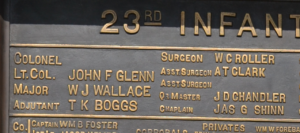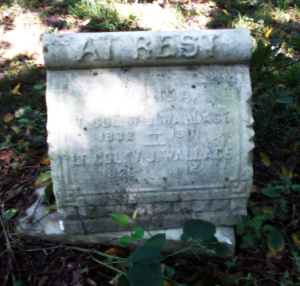Title: Army Lieutenant Colonel, Civil War; bricklayer
Birthdate: November 6, 1827
Death Date: December 5, 1914
Plot Location: Section 108, Lot 23, 2 from north line

It is often said a man isn’t defined solely by the work he does. However, most men in the Wallace family held one occupation for their entire lives, and most of them became skilled craftsmen in the bricklaying business.
William was the second of eight children, six of them boys. His father, a carpenter, arrived from Ireland and married a Philadelphia girl around 1821. One of his sons became a carpenter but William and two brothers practiced their trade with the trowel as their life’s work. He met Amanda Clark and they married in 1849. Over the next decade two girls and two boys made their family complete, and both of their sons followed in William’s footsteps as bricklayers.
Hostilities with the Southern states turned into war in 1861, so William joined the 23rd Pennsylvania Volunteer Infantry in August. He was made captain of Company E.
The 23rd took part in the Peninsula Campaign in the spring of 1862 and engaged in severe fighting at the Battle of Seven Pines. The regiment was fortunate that it missed the Second Battle of Bull Run and the Battle of Antietam. Later that year William became Major Wallace and fought at  Fredericksburg and Gettysburg. His name is on this bronze plaque on the Pennsylvania Monument in Gettysburg, which honors every man from the state that fought there. In December of 1863 he replaced John F. Glenn as lieutenant colonel.
Fredericksburg and Gettysburg. His name is on this bronze plaque on the Pennsylvania Monument in Gettysburg, which honors every man from the state that fought there. In December of 1863 he replaced John F. Glenn as lieutenant colonel.
The Overland Campaign began in the spring of 1864 where the 23rd suffered heavy losses. Four officers and 71 enlisted men were killed at the Battle of Cold Harbor in June. William was one of five officers and 111 enlisted men who were wounded. The extent of his injuries aren’t known but he apparently remained on active duty until his term of service expired on September 8, 1864.
One of the officers killed at Cold Harbor, Lt. John Boyd, is buried in this cemetery. Two corporals who served with the 23rd, Frank Conly and Alexander Johnston, came home from the war and were eventually interred at Mount Moriah. Col. George Spear is also buried here, having started with the 23rd but was killed while leading the 61st Regiment at Fredericksburg.
Colonel Wallace was 36 when he returned home to spend the next 50 years in Philadelphia. He picked up where he left off as a bricklayer until he was no longer able to work. For the last quarter of the century he may have worked alongside his sons. Amanda was almost 70 when she died in 1901. After that, William lived with his children, all of whom enjoyed a long number of days.
As a ranking officer he did his part to advocate for his fellow soldiers. He was a member of two different posts of the Grand Army of the Republic, a fraternal organization of veterans. It was a  powerful political lobby that gained pension benefits for its members and helped elect five presidents who were GAR members. William no doubt attended the national “encampment” of the organization when it met in Philadelphia in 1899. This is a souvenir badge from that event.
powerful political lobby that gained pension benefits for its members and helped elect five presidents who were GAR members. William no doubt attended the national “encampment” of the organization when it met in Philadelphia in 1899. This is a souvenir badge from that event.
His parents were buried at Odd Fellows Cemetery but he buried Amanda at Mount Moriah, and  joined her here after he died of paralysis. His two sisters also had plots here, but none of his children did.
joined her here after he died of paralysis. His two sisters also had plots here, but none of his children did.


Support the Friends of Mount Moriah
Help us in our mission to restore and maintain the beautiful Mount Moriah Cemetery by donating to our cause or volunteering at one of our clean-up events.

